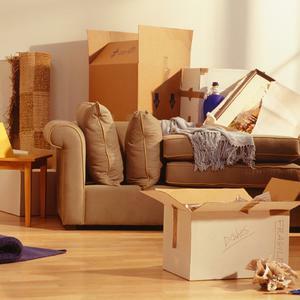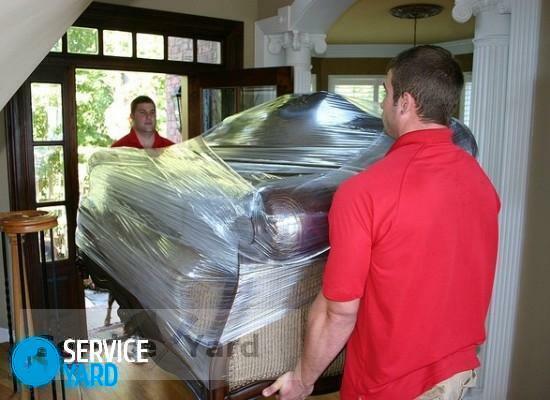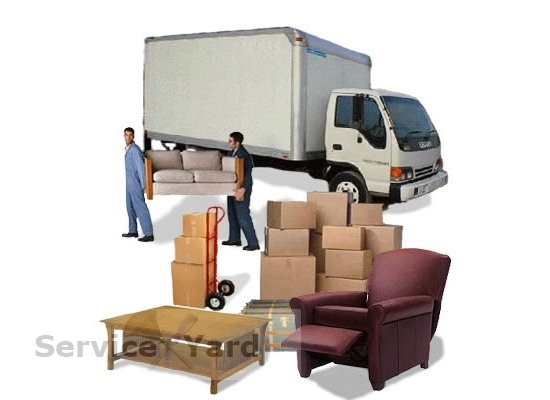
- Preparatory stage
- How to pack correctly when moving?
- The final stage of the
- Useful advices:
The second most "natural disaster" after the repair is the relocation, it's not for nothing that folk wisdom says that two moves are equivalent to one fire. Most likely this is due to the loss caused, because during such an event something is sure to break, fall apart, fail, get lost or crumble. Therefore, the question of how to pack at the move, so that this event is not equated to a fire, flood or tsunami, is relevant and important.
Important! It seems to each person that for comfort and normal life he needs very few things, but when you start to prepare for the move, you realize the true scale of their number. The process of preparing for relocation can take many days. But it's necessary to do everything competently and orderly, then it will not seem so terrible and a little impossible event.
to content ↑Preparatory stage
The preparatory stage will help you not only correctly organize the whole process and securely pack things when moving. Most likely you will be able to find even what you have long since lost or "unearthed" things that in principle you no longer need and benefit from them in the new place will not. Follow the next algorithm and you will successfully cope with the task.
Materials and packaging

Collect all the necessary materials that you will need for packing things:
- Sturdy boxes of various sizes, as you will pack different items in them.
- Durable adhesive tape.
- Wrapping paper.
- Newspapers.
- Air bubble film.
- Scissors.
- Soft fabric, flannel.
- Large and small plastic bags.
- Marking handles.
- Stickers for marking.
Important! Packing materials should be stocked at every opportunity: do not throw away the shoe boxes, large appliances and other bulk acquisitions, and you will not have to pack them for moving.
Sorting documents
Documents - this is something without which it is impossible to imagine your life in society. Whatever you are trying to do, or wherever you are going to go, they will definitely be needed. Therefore, pay special attention to this moment and check everything very carefully.
Assemble the folder with all the important documents you need during the move: a folder with receipts for the ordering of the moving car, information about the carrier company( if any), money for the movers, the necessary contact information and other important documents to keep in a safe place, for example, in a personal bag, so as not to lose and not pack it in a hurry.
Important! Personal documents, bank cards, jewelry and money also need to be transported in a personal bag. If necessary, keep medicines with you.
Throw away the trash
Get rid of excess! Moving is an excellent opportunity to review the need and usefulness of each subject. Do not carry extra "garbage" with you. If you can not figure out what exactly is and what is not, here's a short list of what you should not give 100%:
- Old handles.
- Broken toys.
- Individual tetrad sheets.
- A roll of wallpaper remaining from the previous repair.
- Things that you have not used for 2 years.
- Items stored on "just in case".
- Old utensils.
- Broken furniture.
Sorting personal accessories
Assemble a box or suitcase of personal belongings for each member of the family. This box should contain everything you need in the first few days, while the rest of the things are packed, including:
- Soap. Toothpaste and brush.
- Towel.
- Home clothes and shoes. Razor( if necessary).
- Hygiene items.
- Two complete sets of change clothes.
Important! Keep a box or bag of personal belongings in a safe place so as not to confuse them with other items. It is desirable to immediately mark it and write what it is in it.
Apply old things with the benefit of
Collect clothes that can be used for upholstery. In order not to buy a huge amount of bubble wrap, reconsider your wardrobe. Surely there you will find many things that you have not worn for a long time, but the hand did not rise to throw them away. In this situation, they will be your salvation - such clothes you can pack small items.
Important! Clothes are much more pliable than paper and a bubble wrap, so by this procedure you will kill two birds with one stone: pack clothes, objects and save the budget. For example, each piece of glass can be wrapped in a sock, if even glass products strike against each other, then with such packaging nothing will happen to them.
Correctly prepare the technique for moving
Take a picture of the wires connecting the complex electronics, then connect them correctly. So you will save a lot of time and your own nerves.
to the contents ↑How to pack correctly when moving?
The correct sequence for packaging is the guarantee of the safety of the products during transportation. Therefore, follow a clear plan.
Step 1:
- First of all, create a spacious place to pack in your house. You will need a spacious, cozy space where you can lay out all the items before you start packing when moving.
- At your fingertips lay out boxes, packing materials, markers, labels, scotch tape.
Step 2:
- Carefully wrap each item with clothing, bubble wrap or paper. To avoid breakages, put items in boxes with care and in the most convenient position for them. Things harder to pack at the bottom of the box, and easier - at the top. Try to put as many items in the box as possible to reduce the amount of tare.
Important! Remember the "thumb rule", it concerns the weight of the packing box: it should not exceed 30 kg. After packing things, you have to move the box with your thumb. If it does not, unpack it and put a few things in the next container.
- On the package, mark the name of the room to which these things belong. This will greatly facilitate the process of unpacking after moving. This method can simplify the task of loaders, if they do not rush, then they will lay out all the boxes in the corresponding rooms. Packaging When moving, start one room at a time.
Step 3:
- First, pack everything from mezzanines and cabinets. Bed-clothes, blankets, tablecloths, curtains and other items should be put in plastic bags.
- When packing books, stack them in 15-20 pieces and wrap them in thick paper to protect the soft corners. Brochures are packed in stacks not more than 45 cm high. Do the same procedure with the discs. Gently place all the items in a cardboard box. Fill the void with flannel, garments or air bubble wrap. Each box is sealed with adhesive tape, and for strength, glue with adhesive tape and seams. Do not forget to mark and sign.
- Before packing clothes and shoes, divide the things of all family members so that there are no problems with unpacking and searching for personal items. Demi-season, summer clothes sort by packages or smaller boxes, observing the principle of a thematic collection.
Important! Things that can not be crumpled are packed in fabric covers and placed in large boxes, if you can not translate them by hanging them on your hangers. When assembling things in suitcases, fold them correctly: lay the shoes on the very bottom. Cosmetics and other small things are pushed around the corners to save space. Things that crumple, put on top.
Step 4
 Assemble the cooking utensils:
Assemble the cooking utensils:
- Be sure to wrap sharp objects in a tight cardboard and place them in boxes so that they can not damage anything. At the bottom, lay a layer of foam or old newspapers.
- All individual small items found during the release of boxes in the kitchen are packed in plastic food containers.
- Dishes, glass, transfer air bubble wrap or thin cardboard.
- Place the plates in a vertical position like a plate. Use for packing towels, flannel and various soft cloth.
- Pans and frying pans should be rewound with newspapers to avoid scratching the surface.
- All items collected in the kitchen are carefully packed in a box, and fill the voids with soft material, so that in the event of shaking or falling, the delicate glass objects remain intact.
Important! To properly pack things when moving, in the pan, fold smaller objects of the dishes, pre-wrapped them in rags.
Step 5
- Furniture as far as possible disassemble. All panels necessarily sign and, wrapping them with air-bubble wrap( or stretch film), put in large boxes. At the bottom of the package, put the sheets of corrugated cardboard for depreciation. For small accessories( handles, screws, nuts, fasteners), select a separate pouch or plastic container.
Important! If you decide not to dismantle furniture, then seal all the drawers and doors with adhesive tape. It is also a good idea to photograph the furniture of a complex configuration and number the parts before disassembling.
- Mirrors, paintings, glass doors are packed in cardboard sheets and wrapped with scotch tape.
Step 6:
- Household appliances pack very carefully, it is better to transport it in its original packaging, fixing the foam. If not, use air bubble wrap or flannel. For each instrument, put the documents. If the box is not native, then be sure to indicate the top and bottom of the object.
- Protect the screens of monitors and televisions with layers of bubble film and fix with a stretch film. Disconnect all wires and cables and tape them with tape.
- Separately it is necessary to pack flammable substances: varnishes, solvents.
Important! On each large package write a list of groups of things with a marker and put the number. Duplicate the entry in the notepad to save time and effort when unpacking.
to the contents ↑Final stage
Assemble the box with the name "open first", which will contain the items needed during the move. It should be:
- Roll of paper towels.
- Liquid for washing dishes.
- Sponge.
- Several pens.
- Plastic or paper plates.
- Plugs.
- Spoons.
- Towels for each member of the family.
- Casserole.
- Frying pan, etc.
Important! People who will help you pack things when moving, take out, bring them, you will need to wash your hands, eat, after you have finished unpacking.
We load things into the machine
 When loading things, follow and control the process:
When loading things, follow and control the process:
- First of all, load the dimensional things.
- The hardest and most stable should be at the bottom, and on top - light trifles and suitcases to make a kind of pyramid.
- Plants and fragile things are better to immerse in a car.
Important! After you free the rooms, be sure to clean up in all rooms to leave a good impression of yourself to the new owners.
to the contents ↑Useful advices:
- To secure the boxes, use a special packing tape, not scotch tape.
- You can use garbage bags for packing towels, shirts and unbreakable things - just take the biggest ones and with good density.
- Use pillowcases to pack portraits, pictures, photos.
- Bags with clothes are used as barriers between fragile things or fill them with empty spaces in the truck.
- Chest drawers can not be emptied. Fragile things that are in them, put on towels or socks, so they do not break.
- To protect your hands during the move, keep workers or garden gloves on hand. They will be needed for both loading and unloading.
- Do not take empty boxes from grocery stores, as they may contain eggs of insects. Use boxes for office supplies or buy new boxes in the moving companies.
If you use our advice and recommendations, moving for you will not be a disaster, just start collecting things as early as possible in order to avoid rushing.


